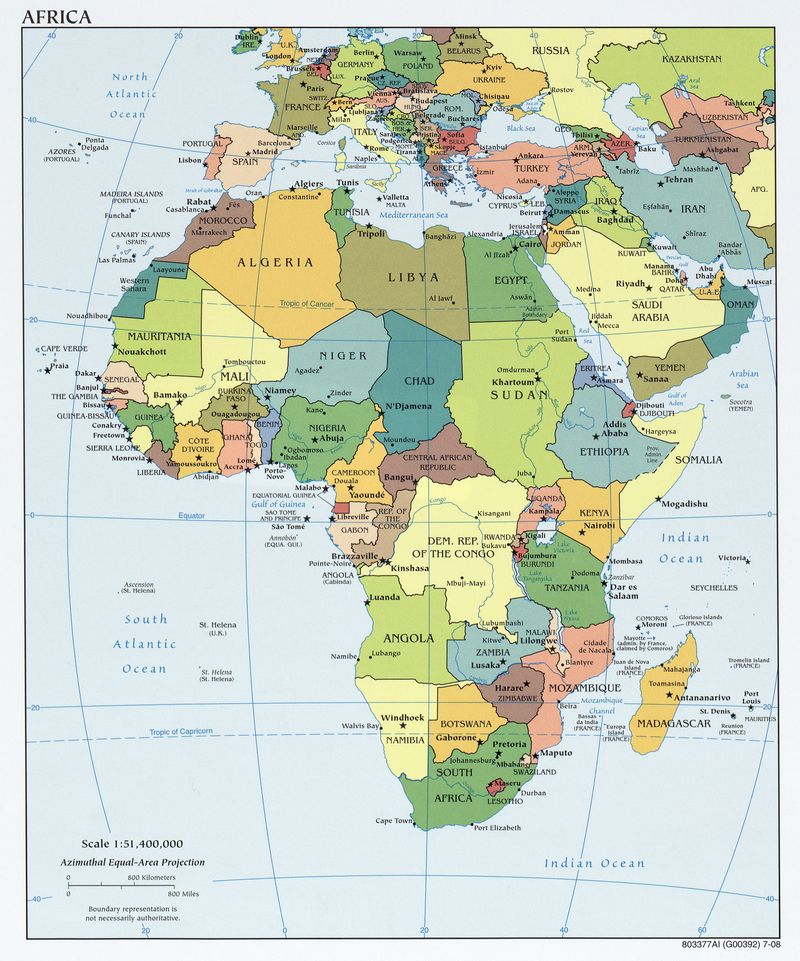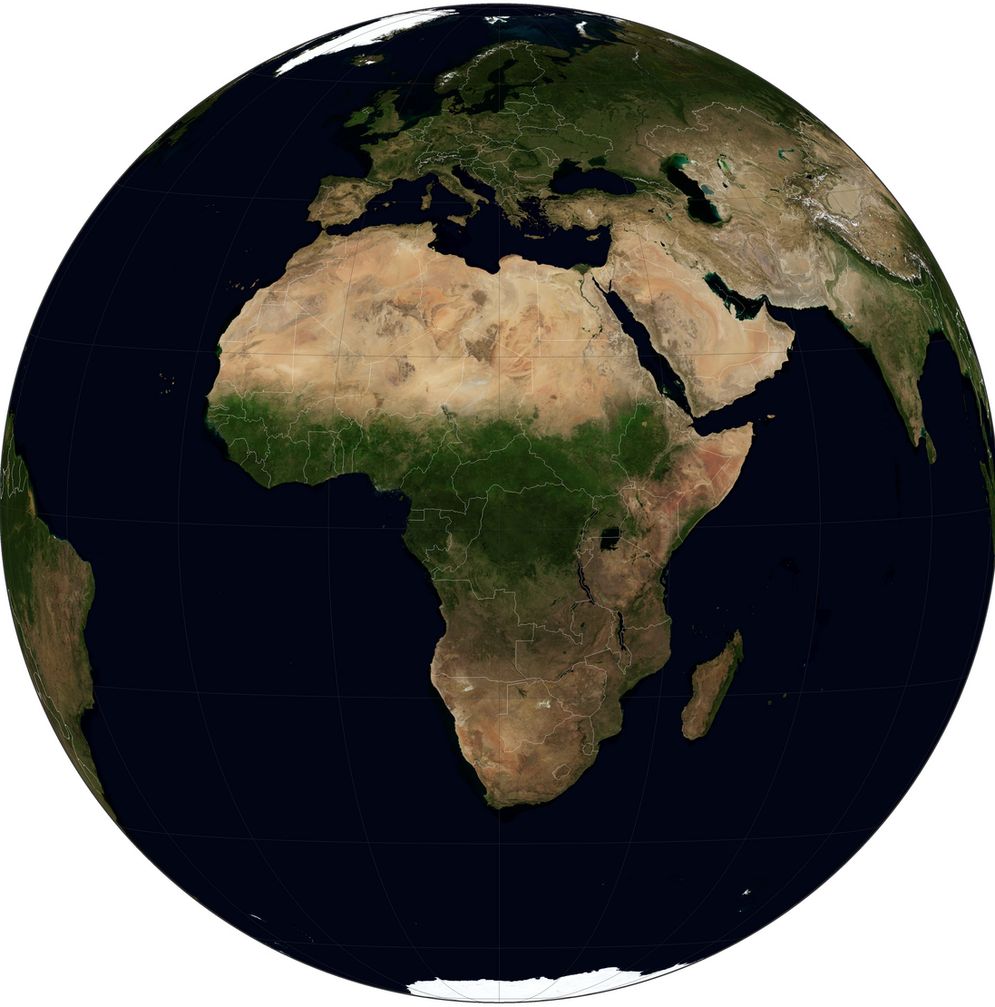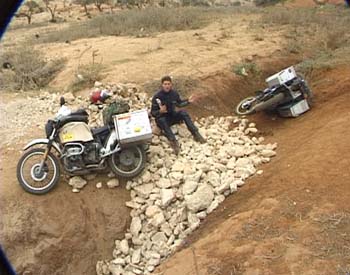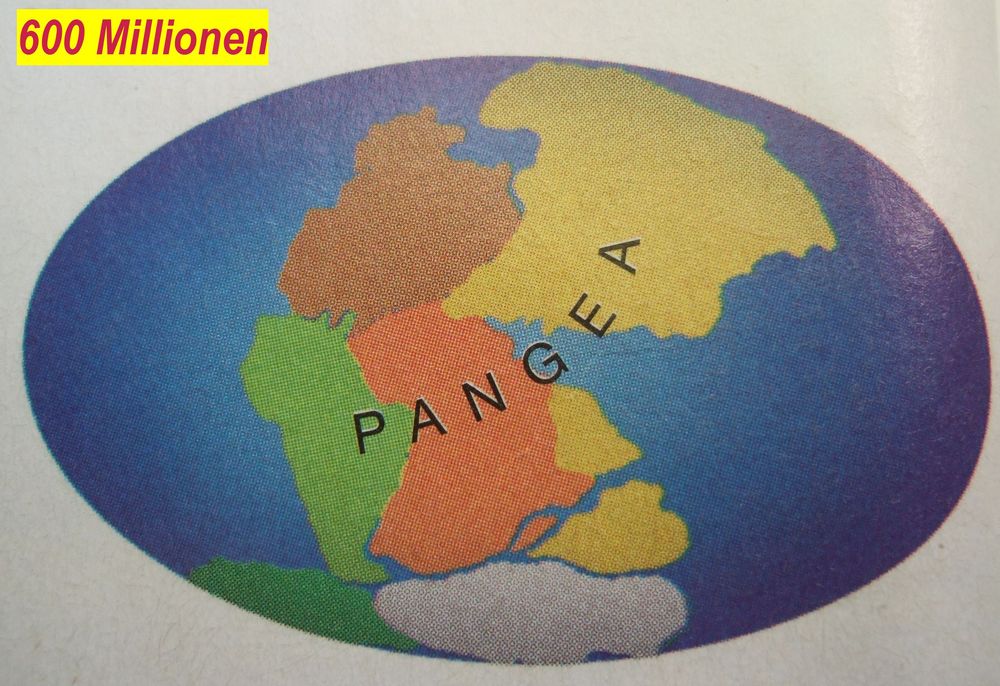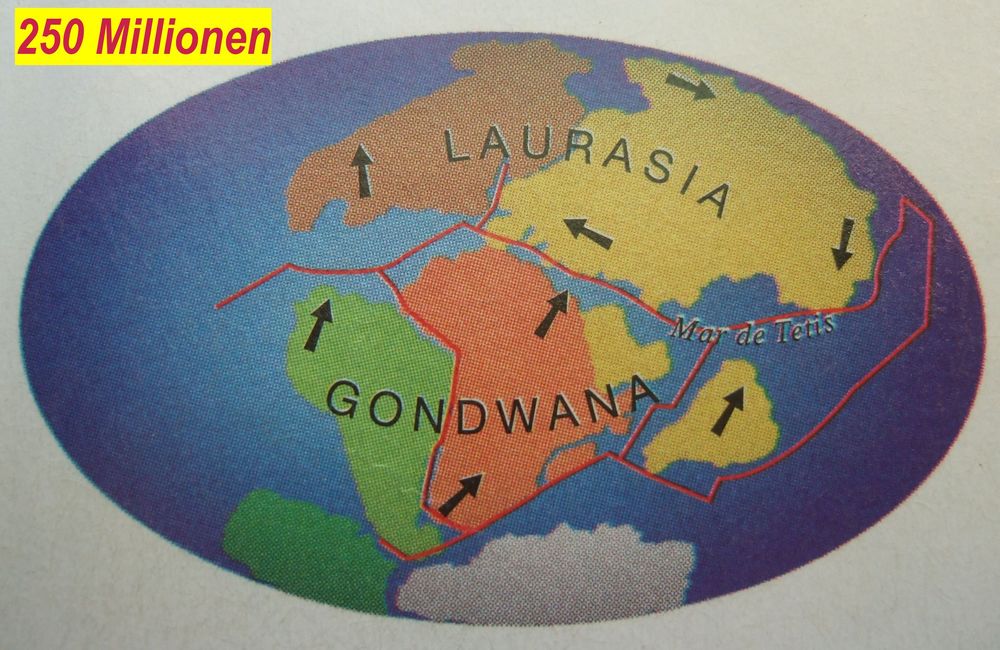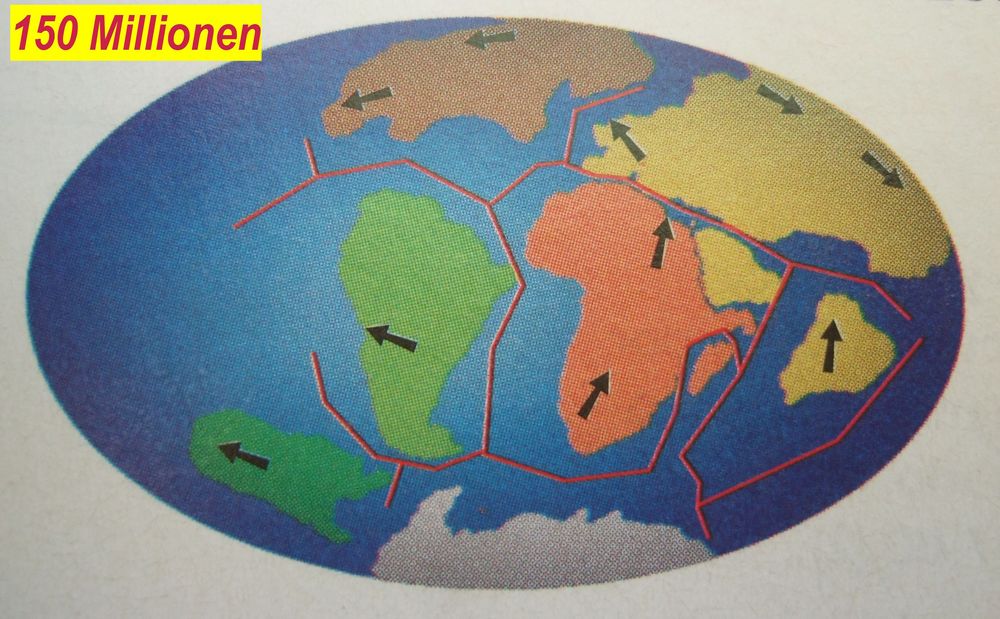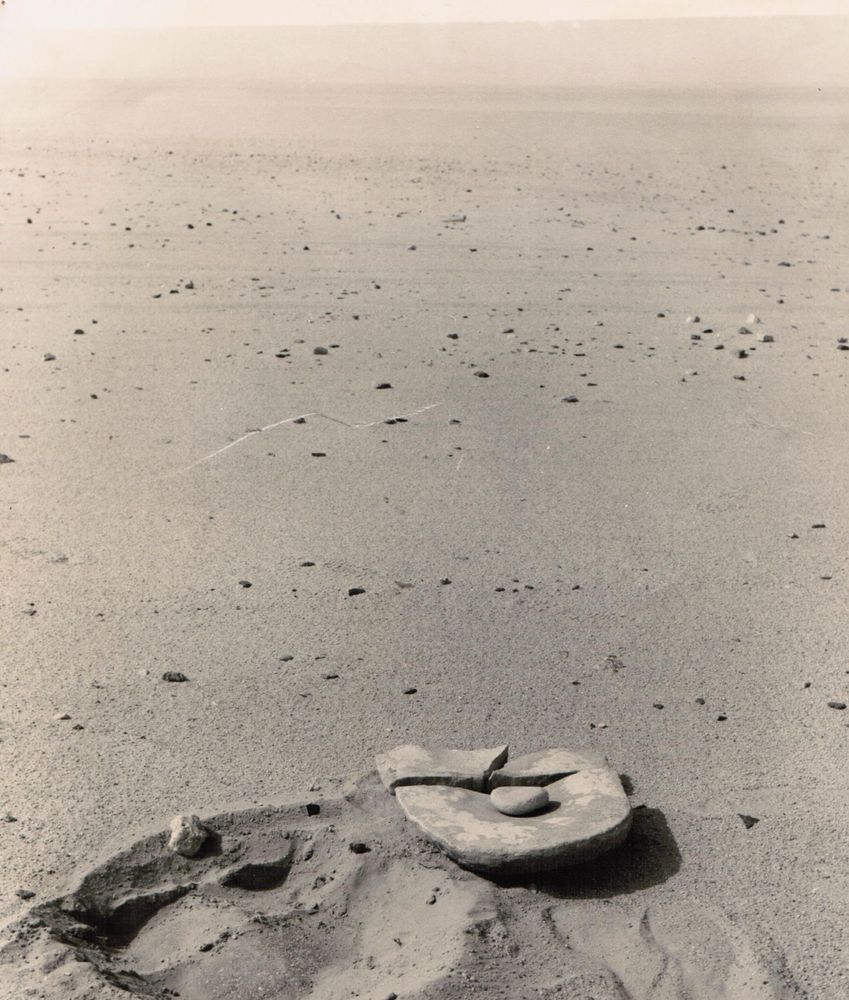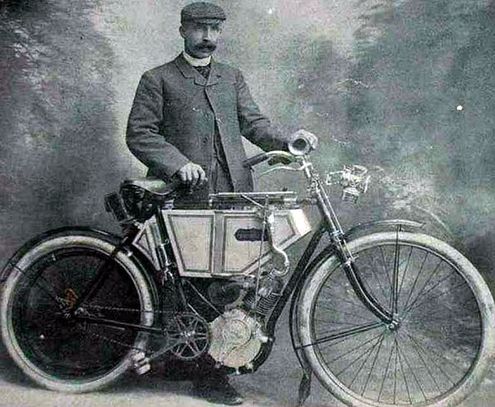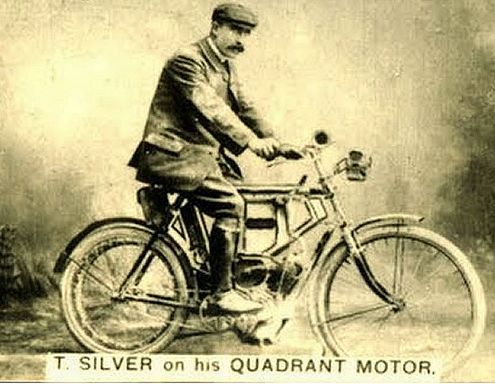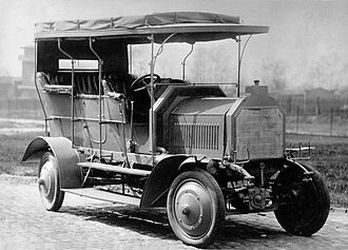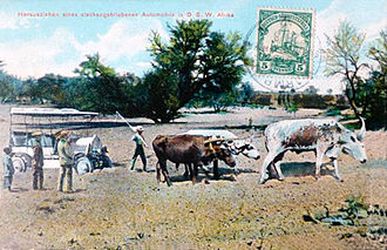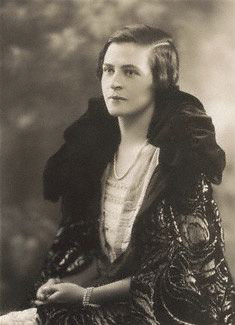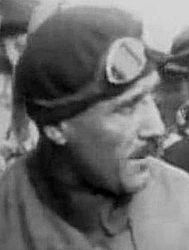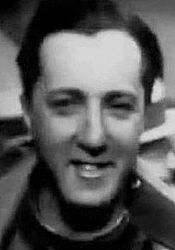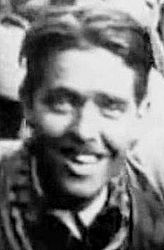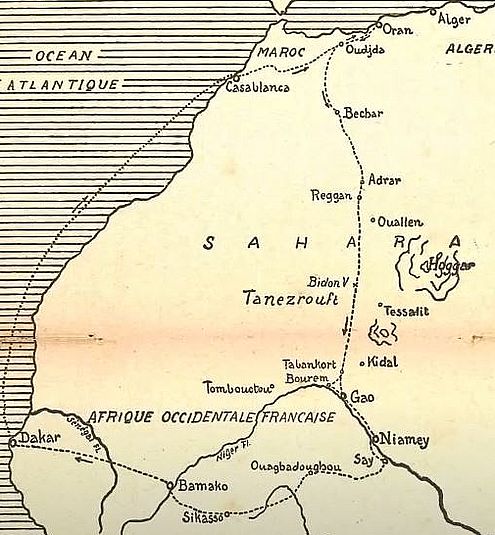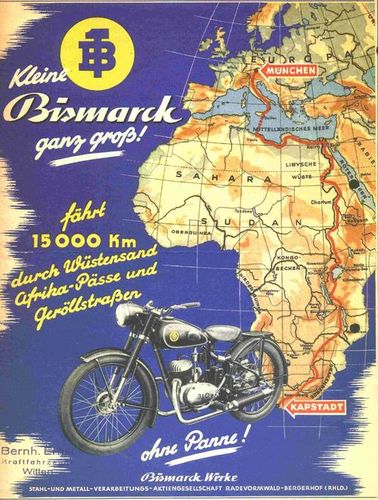1930-1939
1930
Motorrad mit Beiwagen fährt von Alexandria nach Kapstadt und Lobito. Keine Details mehr bekannt.
22.06.2000 Who knows more ?
1930 - 40
Die Hoggar - Route (Alger - Tamanrasset - Agadez - Kano - Fort Lamy) wurde fahrplanmäßig von der Satt (Societe Automobile de Transports Tropicaux) befahren.
1930 - 40
Die Tanezrouft - Route wurde mit Wüsten - Autobussen von der "Compagnie Generale Transsaharienne" befahren.
Route: Oran - Colomb Bechar - Reggan - Bidon V - Gao.
1930
Algeria
- Belgisch Congo.
Der Franzose Pierre Martineau fuhr solo
ab 02/1930 mit einem Solo - Motorrad Peugeot P 107 (350 ccm).
Route:
Alger - Gao - Tschadsee - Elisabethville. Er führte einen extra Wassertank
von 60 Liter mit sich. Wegen dieser außergewöhnlichen Reise wurde er
auf dem Titelblatt der Moto Revue des Salon de Paris von 1930 abgebildet.
18.05. - 15.10.1930
A.W. Hayter
Cape
to Cairo by sidecar. Der Engländer A.W. Hayter war der erste Engländer, der diese
Traumroute, die vorher nur vom Flugzeug und Auto bewältigt wurde, meisterte.
Er reiste mit einem Gespann "Sun - J.A.P.". Sein Neffe, Mr. W. B. Boulton,
war im Seitenwagen sein Begleiter. Dieser bekam aber Fieber in Kenya, so daß Hayter von dort alleine bis Cairo fuhr. Als er ankam, hatte er 6.500 Meilen gefahren,
davon 3.000 ganz alleine.
25.06.2000 Da die dokumentierten Informationen
von Cliver 1921 fehlen wird dieses oft als die erste Motorrad-Tour Capetwon -
Cairo gesehen.
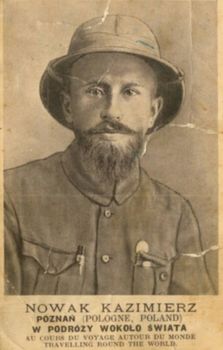 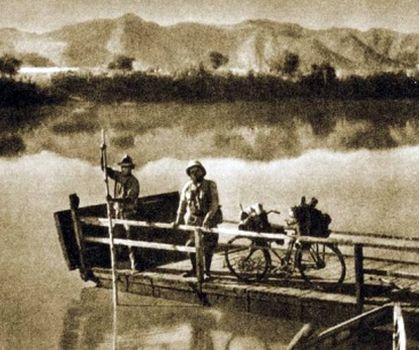 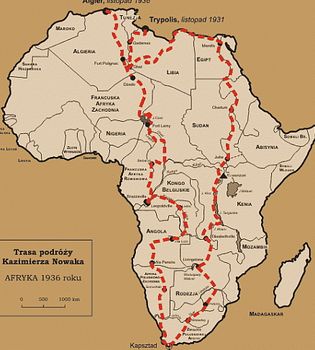
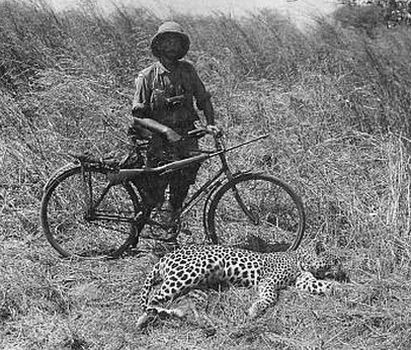 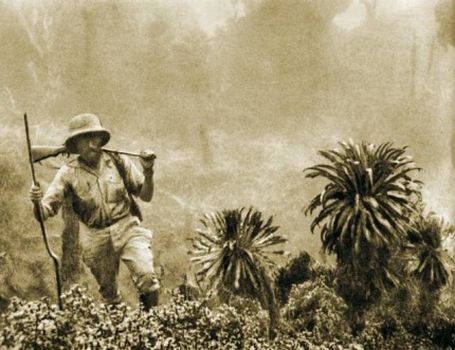
Fotos from WIKIPEDIA and
http://www.makethman.com/2010/06/27/kazimierz-nowak-1897-1937/
??.11.1931-??.11.1936 (end of Afrika) -23.12.1936 Poland.
Kazimierzu Nowaku (Kazimierz Nowak (* 11. 01.1897 in Stryj. † 13.10.1937 in Poznań (Posen))
+ Transafrica two times. Cairo - Capetown. Capetown-Alger.
Purpose: Kazimierz Nowak was a polish world-traveller, fotograf and correspondent. From 1931 to 1936 he crossed Africa solo by bicycle and on foot from north to south and back another route appr. 25.000 miles (40.000 km). He wrote many letters to his wife. And took 10.000 fotos: http://www.makethman.com/2010/06/27/kazimierz-nowak-1897-1937/ He described in the letters the African culture, mentality, religion and nature.
Route: Europe (Poland - Italy (Rome) by train. By bicycle to Nepal. From here he took the boat to Africa (Libya (Tripoli) - Egypt - Sudan- Belgian Kongo- Rhodesia- after three years he reached South Africa (Cape Agulhas. April 1932).
Back-Route: South Africa- South-West-Africa (here the bicycle fall aprt in pieces. Hecontinued 3.000 kms with two horses until Angola)- Angola- two-month single voyage along the rivers of Lulua, Kassai and Kongo until Belgian Congo (Leopoldville, today Kinshasa)- by bicycle via French Aequatorial Africa- to Chad (Fort Lamy) - with a dromedary "Ueli" he reached Algeria (Djado- (O)uargla. He travelled the last 1,000 kilometres from Quargla to Algiers on the coast of Mediterranean Sea, by bicycle. He reached Algers in november 1936. By ferry to Europe (France - (Paris, where he arranged visa formalities to cross)- Belgium and Germany . Poland).
The best: Kazimierz Nowak became the first man in history to travel the length of Africa – and back again – alone.
Publication: After he came home he gave several reports. Book so far in Polish.
Two books: Über die Reise wurden dank seiner Tochter Elżbieta Nowak-Gliszewska und Łukasz Wierzbicki zwei Bücher veröffentlicht:
"Kazimierzu Nowaku. Przez Czarny Ląd (Durch das schwarze Land). His daughter published this book in ??.
"Kazimierzu Nowaku. Rowerem i pieszo przez Czarny Ląd (Mit dem Fahrrad und zu Fuß durch Schwarzes Land). 2000. Publ. Wydawnictwo Sorus (Translataion: Kazimierzu Nowaku. By bike and on foot through the Dark Continent. Published by the Poznań Publishing Sorus. Polan.)
Author: Lukasz Wierbicki. Booktitel. Afryka Kazika. Publ. PUBLIKON Kiadó veröffentlicht.
Translation by PC out of website: http://www.lukaszwierzbicki.pl
Ever since I can remember, my grandfather, Joseph Wisniewski, he shared with me lots of fascinating history. Among them the important place occupied always stories about Kazimierz Nowak, Poznan traveler, who in the years 1931-1936 took a fantastic trip to Africa, and the fate of my grandfather as a boy followed on a regular basis in newspapers and magazines.
- Also from Grandpa I learned that the only postwar publishing house dedicated Nowak was prepared by the daughter of a traveler, Elizabeth Nowak-Gliszewską album Through the Dark Continent, with over three hundred photographs taken by him, but even contains trace information about the Nowak and his journey.
-
In 1998, inspired by the stories dziadkowymi I went to the library with the intention to find reports of signed name of Kazimierz Nowak.
- "Yes, it was about this trip I told you about" - was glad grandfather, when I brought him his first copies of archived articles. Excited get me back for another relationship, remember, in which the magazines, which appeared a few years. Spring of 1998 I sat in the library. In search reports Kazimierz Nowak looked through hundreds of volumes and rolls of microfilm archives numbers "Kurier Poznanski", "Światowida", "On the wide world," "Around the World", "Illustration Polish" and "Catholic Guide" from the years 1931 to 1937. The work lasted several months. Finding libraries subsequent correspondence from Africa, amazement and admiration got to know the extraordinary adventure traveler.
-As a result of research in libraries I reached over a hundred press relations, coming from different stages of the journey Nowak. Unfortunately, despite the efforts I could not find a family traveler and get to the source material. The next stage of the study was to rewrite all the letters, laying them in chronological order and drafting in such a way as to form a unified story. The task was not easy. Sometimes the fragments taken from several different reports Nowak were able to submit one short fragment, which was suitable as a chapter book just emerging. I knew, moreover, that played in this way the relationship is lacking, but at the same time I was aware that I have here in front of you not only fascinating, beautiful literary language of a written story, but also a unique document detailing Africa 30s of the twentieth century, witness of a superhuman feat, and the relationship one of the most extraordinary journeys in the history of the exploration of the Dark Continent.
- Bicycle and on foot - first edition in 2000, a book called by bike and on foot through the Dark Continent published by the Poznań Publishing Sorus went to bookstores. It seemed to me then that task to perform which inspired me stories of Grandpa has been done. I was wrong ... It must simply be another six years to two copies of the book with a thousand printed in 2000 found their way into the hands of people who made that history rolled on ... and it's extremely rapidly!
- In early 2006, a book of Kazimierz Nowak picked up Maciej Pastwa, Poznan globetrotter, threw her backpack and headed for his next journey, this time in Iceland. He reached for it during the voyage across the North Sea and moved by reading he decided that he must do something to commemorate the journey Nowak. He decided to fund a plaque dedicated to the traveler of Poznan.
- I knew that once again I have to get to work edited books bicycle and on foot through the Black Continent. This time my disposal a complete source material. The work took a year. The book with its 150 pages has grown to 400-page book contains more than 150 photographs, the vast majority never previously unpublished. Motto scoop the Kazimierz Nowak of the letter to his wife written on the River ivory in the June 1934 year:
"O Maryś! - As I really wish to have time to write a book - so thick - interesting - and one of the first ezgemplarzy just dedicate hand, my Beloved Marysieńce '. But this is only a dream - until coincide lot before critics take me in his claws ... "
Writing these words Kazimierz Nowak did not know how much time has elapsed ... The book was published exactly 70 years after the author's death and ... has been hailed by critics one of the most important position in Polish literature of travel. She went through five editions and Kazimierz Nowak reappear in countless reportages press, radio and television, was the hero of the comic book, a board game, an animated film and pop-culture icon worn on T-shirts. Children, readers Africa Kazik, with enthusiasm and imagination doing art work illustrating his adventures. Cyclists are planning expeditions in his footsteps. Since May 2009, School No. 5 in Poznan bears the name of Kazimierz Nowak.
Bicycle and on foot through the Dark Continent among readers arouses intense emotions, for many of them it becomes a lesson in perception of the world with respect, kindness and interest, inspired to serve their own journey, the beginning of a great adventure. So it was in my case. Inspired by stories dziadkowymi trip to the library proved to be the beginning of one of the greatest adventures of my life
As a result of research in libraries I reached over a hundred press relations, coming from different stages of the journey Nowak. Unfortunately, despite the efforts I could not find a family traveler and get to the source material. The next stage of the study was to rewrite all the letters, laying them in chronological order and drafting in such a way as to form a unified story. The task was not easy. Sometimes the fragments taken from several different reports Nowak were able to submit one short fragment, which was suitable as a chapter book just emerging. I knew, moreover, that played in this way the relationship is lacking, but at the same time I was aware that I have here in front of you not only fascinating, beautiful literary language of a written story, but also a unique document detailing Africa 30s of the twentieth century, witness of a superhuman feat, and the relationship one of the most extraordinary journeys in the history of the exploration of the Dark Continent.
Bicycle and on foot - first edition in 2000, a book called by bike and on foot through the Dark Continent published by the Poznań Publishing Sorus went to bookstores. It seemed to me then that task to perform which inspired me stories of Grandpa has been done. I was wrong ... It must simply be another six years to two copies of the book with a thousand printed in 2000 found their way into the hands of people who made that history rolled on ... and it's extremely rapidly!
In early 2006, a book of Kazimierz Nowak picked up Maciej Pastwa, Poznan globetrotter, threw her backpack and headed for his next journey, this time in Iceland. He reached for it during the voyage across the North Sea and moved by reading he decided that he must do something to commemorate the journey Nowak. He decided to fund a plaque dedicated to the traveler of Poznan.
Organization:
08.04.2016 Am 08.04.2016 waren Patricia und Bernd T. zu Gast bei den Veranstaltern von www.lagerfeuer-duisburg.de in Duisburg / Steinbruch. Der polnische „Geschichtenerzähler und Autor“ Lukasz Wierzbicki hielt einen wunderbar-präsentierten Digi-Dia-Vortrag über eine Motorrad-Reise 1936 von Polen Nach Shanghai (http://www.berndtesch.de/DOMAIN-BERND-TESCH-DE/English/Continents/Asia/Asia.html ). Dabei erwähnte er erstmalig für B.T. diese Transafrika-Reise.
12.04.2016 Aufbereitung dieser Zusammenfassung.
??.02.1933 - 19.06.1933
Hermann Jerutka (geb. 10.08.1907 in Böhmisch Aicha nahe Reichenberg)
+ Marokko, Tunesien, Algerien per Rucksack. Ankunft mit dem Schiff in Melilla, Marocco, im Feb.33. Danach Seereise über Alhucemas nach Ceuta; weiter über Tetuan, Tanger, Alcazar, Meknes, Fez, Taza. Einreise Algerie nach Oman, weiter über Orleanville. Ankunft Algier am 1.April 1933. Über Setif , Constantine, Bone nach Tunis. Verlassen Tunis am 24. Mai 1933 Richtung Sahara. "Das ist mein Afrika, von dem ich in meinen Jugendjahren geträumt habe.. Souk-Ahras, Timgad, El Kantara, Biskra, [...]. Meinen Rucksack lasse ich in Biskra zurück und ich wandre durch die Oase auf der Straße nach Süden. Schöne Palmen wachsen in großer Anzahl von niedrigen Lehmmauern umgeben, es ist ein einziger Garten von Wassergräben durchzogen, die die Oase überall hin bewässern [...]. So sitze ich und lasse den Sand durch meine Finger rieseln. Ich sehe nur Himmel und das ewige Sandmeer. Alles ist ewig, nur ich kleiner sterblicher Mensch sitze hier. Ich komme mir in diesem Augenblick ganz winzig und unbedeutend vor [...]". Abreise Biskra: 30.05.1933. Abreise Tunis Richtung Sizilien: 19.06.1933, danach Sizilien-Reise..
Sohn Heiner Jerutka 28.03.2008: Dies sind nur Auszüge aus dem Tagebuch, das zum Teil durch Fotos und wahrscheinlich Zeitungsbilder ergänzt wird, darüber hinaus existiert ein Kriegstagebuch, auch sehr beeindruckend, aus der Zeit des Afrikafeldzugs und der anschließenden Zeit der Gefangenschaft (USA). Ich hoffe, dass Sie diese Angaben interessiert haben, wenn Interesse besteht, kann ich Ihnen auch noch Fotos einer selbst erstellten Landkarte schicken. Übrigens, mein Vater war Designer und hat seine Bücher zum Teil selbst illustriert, durch Werbezeichnungen hat er sich während seines Aufenthaltes ein wenig Geld verdient. Auftraggeber Bata Schuhe und Messner Tee, eine eher lustige Anmerkung.
28.03.2008 Übersandt auf Bitte von B.T. vom Sohn Heiner Jerutka.
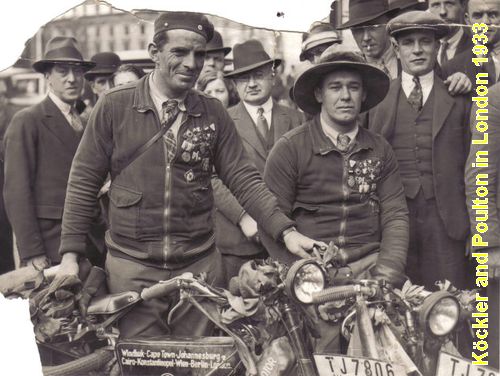
Richard S. Köckler and Kenneth D. Poulton 1933. Foto kindly send to B.T. 20.03.2009 by Bryan Poulton in Capetown, grandson of Kenneth.
http://i179.photobucket.com/albums/w288/diablovtse/London1933.jpg
http://i179.photobucket.com/albums/w288/diablovtse/Trip.jpg
http://i179.photobucket.com/albums/w288/diablovtse/AfricatoEurope1.jpg
http://i179.photobucket.com/albums/w288/diablovtse/AfricatoEurope2.jpg http://i179.photobucket.com/albums/w288/diablovtse/AfricatoEurope3.jpg http://i179.photobucket.com/albums/w288/diablovtse/AfricatoEurope4.jpg
Copyright: Brian Poulton
Ende 11.1931 - >> 12.01.1933
Richard S. Köckler and Kenneth D. Poulton
+ Transafrica.
South Africa - East-Africa - Cairo. Richard Köckler, ein ausgewanderter
Deutscher, wollte mit dem neuen Sachs - Motor eigentlich einen Handel in Windhuk
(früher Deutsch - Südwest - Afrika) einrichten. Infolge einer Wirtschaftskrise
kam es nicht dazu. So kam er auf die Idee, mit seinem "Muster eines Sachs - Rades"
Afrika zu durchqueren. 1931. Fichtel & Sachs - Motor (74 ccm, Zweitaktmotor,
Zweischeiben - Kupplung, Zweigang - Getriebe, Durschnittsgeschwindigkeit 30 km/Std,
einbaubar in jedes Fahrrad).
Mit dieser "Westentasche - Maschine" durchqueren
sie mit 16.000 km Afrika in 7 Monaten. Am 15.02.1996 schrieb mir der 86 - jährige
Robert Schultheiss (siehe dort, 1934 per Gespann nach Capetown), daß er
1934 auf der Polizei - Station El Aduscha in der Sinai - Wüste eine Eintragung
fand, daß sie am 12.01.1933 dort waren.
Route: Süd - Afrika
(Windhuk - Kapstadt - Johannesburg (Start 03.06.1932 now accompanied with an English journalist Poulton - Transvaal) - Rhodesien (Viktoria - Fälle) - Ostafrika
(Tanganjika - See - Njassa - See - Kilimandjaro - Nairobi) - Sudan (Juba - Chartum by ship)
- Ägypten (Assuan - Kairo (Arrived around Christmas) - Jafa - Beirut - Adana - Türkei (Angora)
- Istanbul - Sofia - Österreich (Wien) - Deutschland (München - Schweinfurt
- Berlin) - England (London).
06.08.2004 Evald Bengtsson send me a copy of
a newspaper of THE MOTORCYCLE with a picture
25.064.206 Bryan Poulton from Capetown asked me if I know more about his grandfather.
25.06.2006 I asked Kenneth for update.
20.03.2009 I got many pictures of a Sachs-brochure
by email. And asked for a CD or DVD.
20.03.2009
I asked Bryan Poulton if he knows the exact dates of aariving in GB and what happened to Richard S. Köckler later.
1931
Transafrica. Die deutschen Fern - Fahrer Dingler, Mielke und Millauer durchquerten
Afrika von Nord nach Süd und zurück mit zwei 500 - er Standard - Maschinen
mit Stoye - Seitenwagen (14 PS, Gesamt - Gewicht 400 Kg) in sechs Monaten. Zeitweilig
fuhren sie im Konvoi mit einem Rollce Royce.
Quelle: Ernst Leverkus Bericht.
Ca. 1931
Transafrica. Cairo-Capetown. Die
Engländer Johnson und Farrel durchquerten Afrika mit einem Ariel -
Gespann in drei Monaten und zwei Tagen: Cairo - Khartum - Capetown: 7.800 miles
(= 12.500 km)
Quelle: Ernst Leverkus.
Ca. 1931
Werner
Tödt bereist mit einer Ardie mehrere Jahre Afrika.
Quelle: Ernst
Leverkus.
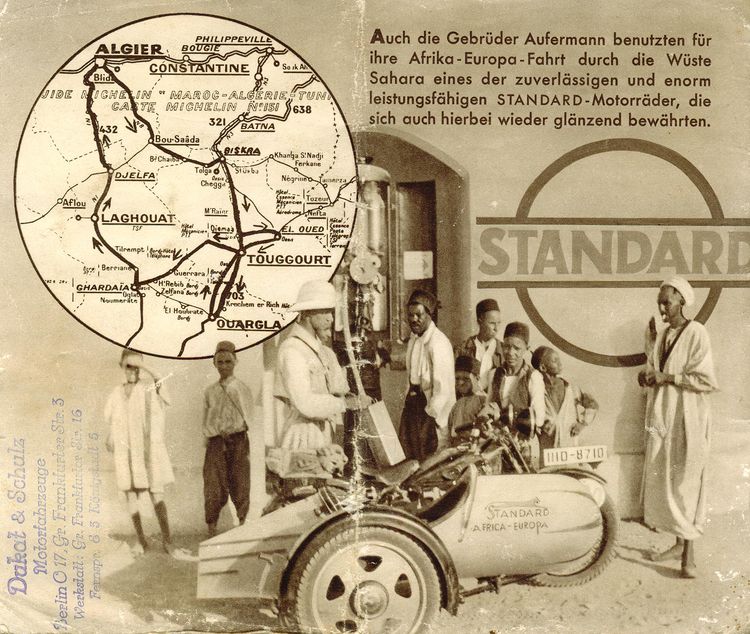
Aufermann. Rückseite des Stolz-Prospektes über die Afrika-Expedition von Millauer.
Orignalprospekt bei B.T.
01.09.1928 - 10.03.1929
Willi (Wilhelm) Aufermann und Fritz (Friedrich) Aufermann (1912 - 1999)
+ Europa-Afrika-Asien-Europa. Die Gebrüder Aufermann aus Essen-Borbeck sind 1928 mit einer 200er DKW E bis nach Jordanien gefahren. Etwas über sechs Monate waren sie unterwegs. In Jordanien haben sie den ersten König Abdullah I. von Transjordanien getroffen.
Route: Europa (Germany - Tschecho-Slowakei - Österreich - Ungarn - Rumänien - Jugo-Slawien - Bulgarien) - Asien (Türkei - Kleinasien - Arabien - Syrien - Transjordan - Palästina) - Afrika (Ägypten - Sudan) - ?? wie vom Sudan bis Kreta ?- Europa (Insel Kreta - Griechenland - Italien - Monaco - Frankreich - Spanien - Frankreich - Belgien - Luxemburg - Holland - Germany).
Fotos: Von der 1928/29 Tour gibt es nur einige Fotos mit Wasserzeichen von einer Auktion. Das Fotoallbum ist in den 90er Jahren verschwunden und in einer Auktion versteigert worden. Der Käufer hat alle Bilder raus genommen und einzeln verkauft
Organisation:
2009: http://www.autotechnikauktion.de/mg/archiv.php?auktion=16&&dkat=&search=&stype=&suche_archiv=&kategorie=-1&start=821&katalog=16&SESSIONID=&L=1
Fotoalbum einer Auktion: "Weltreise der Gebrüder Aufermann-Essen auf einem steuer- und führerscheinfreien DKW-Motorrad E 200", insges. 79 s/w-Aufnahmen; darunter Aufnahmen Empfang in Berlin, sowie Empfang durch den ADAC in Saarbrücken; Empfang durch den Minister des König Abdullah von Transjordanien; einzigartiges Zeitdokument; wunderschöne Aufnahmen.
05.2016 Heinz Schulze informiert B.T. Erstmalig über diese Reise
26.05.2016 Heinz Schulze sendet ein Update mit Fotos von König Abdullah I. von Transjordanien.
Im November 2016 fliegt Heinz nach Jordanien, um im königlichen Fotoalbum vielleicht noch mehr Bilder zu finden. König Abdullah II. habe ich am 24.05.2016 angeschrieben und meine Bitte vorgetragen. Mal schauen was passiert.
Ca. 1931-32
+ Afrika. Das Bruderpaar Willi (Wilhelm) Aufermann und Fritz (Friedrich) Aufermann (1912 - 1999) Essen
bezwang auf zwei Gespannen die Sahara und
Afrika.
Route: Europa (....) - Afrika (Algerien).
Die Aufermänner waren ganz bestimmt nur mit einem Standard-Gespann unterwegs (Heins Schulze).
-
1932 haben sie an einer Polizeisternfahrt teilgenommen. Es zählte damals die Luftlinie. Das Ziel hieß 1932 Kaiserslautern. Sie sind zur algerischen Sahara gefahren und von dort los gefahren. Davon hast Du ja auch eine Karte. Ich füge mal das Original Tankstellenbild bei, das im Standardprospekt benutzt wurde (das hast Du ja auch!). Achte mal auf die Beiwagenbeschriftung!!!!
- Friedrich Aufermann hat noch an einigen Deutschlandfahrten erfolgreich teilgenommen. Auf einer Viktoria mit Hakenkreuzbinde am Arm.
- 1935 sind sie mit dem Auto Nonstop durch die Sahara in 73 Stunden und 45 Minuten gefahren.
-
1930 Willi Aufermann ist mit seiner 20jährigen Schwester von Konstantinopel bis nach Barcelona gefahren. In einem DKW F1 Auto.
Organisation:
1991: Quelle: Ernst Leverkus. "Mit dem Motorrad durch die Sahara". Vermutlich Artikel in "Auto Motor und Sport (?). 1932. Heft 44.
26.02.2011 B.T. hat Afrikateile und 1 Prosepkt von Ernst Mielke gekauft. Auf der Rückseite des Prospektes der Gespann-Firma "Standard" "Mit Vollgas durch die Wüste und Busch" steht, dass die Gebrüder "Aufermann" auf ihrer Afrika-Europa-Fahrt durch die Wüste Sahara eines der zuverlässigen und enorm leistungsfähigen STANDARD-Motorräder benutzen.
26.05.2016 Heinz Schulze
ergänzt die Infos sehr qualifiziert (siehe oben).
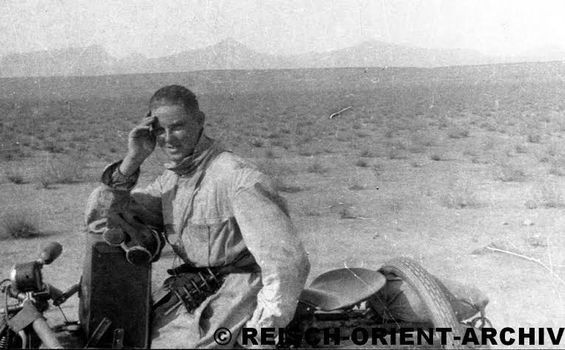 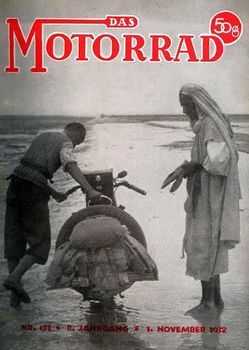
1932. Max Reisch in Nord-Afrika. (C) Peter Reisch
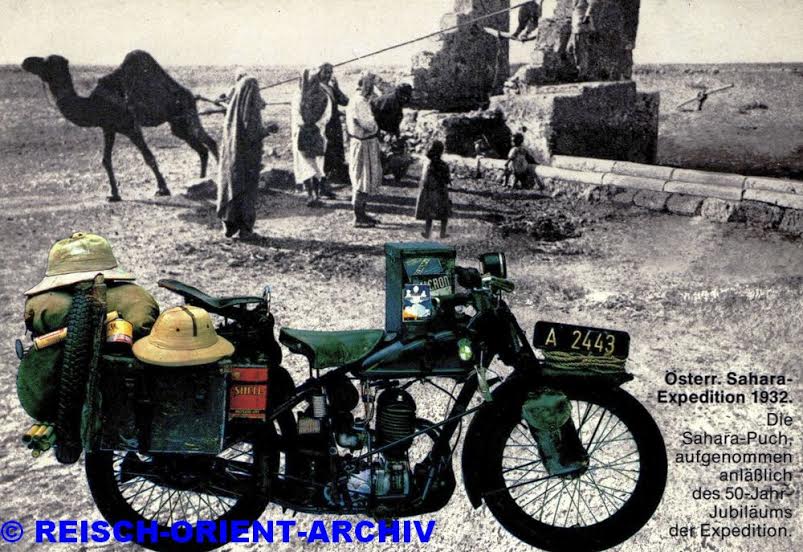
1932. Max Reisch in Nord-Afrika. Fotomontage wohl 1982 zum 50-jährigen Jubiläum. (C) Peter Reisch
1932
Max Reisch (* 02. 10.1912 in Kufstein / Austria. † 18.01.1985 in Kufstein / Austria. Öterreichischer Reiseschriftsteller, Geograph, Journalist und Orientfachmann (Wikipedia).
+ Nord - Afrika. Der Österreicher Max Reisch und Alfred Schricker (Nürmberg) reisten als "Testfahrt" vor Reisch´s wohl schon im Kopf geplanten Indien-Motorrad-Reise 1933-34 nach Algerien und Tunesien per Motorrad: Puch. 250 ccm. Bj. 1929. Spezialausrüstung. 9600 km.
Route in Afrika:
Marocko. Algerien. Tunesien. Libyen.
Publikation: Das MOTORRAD 1932
29.06.2014 + 30.06.2014 Freundliche Information des Sohnes von Max Reisch, Peter Reisch in Bozen / Tirol.
1933
Robert Schultheiss, den ich in 1995 86-jährig gefunden habe,
beschreibt 1996 in einem Brief an mich eine Geschichte. Er hat 1934 unterwegs
in Nairobi einen finnischen Motorrad - Fahrer (Name hat er vergessen...) getroffen,
der mit einem Freund schon 8 Jahre unterwegs war. Über seinem Gespann hatte er eine Plane als Wetterschutz gegen Hitze und zur Übernachtung gespannt.
Der Freund hatte allerdings unterwegs einen "accident": Er hatte in Australien
geheiratet und war dort geblieben. Er war alleine auf dem Wege nach Ägypten.
Er hatte ein Album bei sich, daß von lauter hohen Persönlichkeiten
und Behördenleitern aus aller Welt unterzeichnet war. Wer dieser Motorrad
- Traveller war, konnte ich nicht herausbekommen.
Ca. 30.07.1933
Robert Suhr, einer bekanntesten Karlsruher Leichtathleten, verläßt
1930 Karlsruhe und ist Gymnasial - Lehrer der Höheren Deutschen Privatschule
in Windhoek in Süd - Afrika. Der Studienassessor und Gruppenführer der
NSDAP, Robert Suhr, ist rund 10.000 Meilen mit seiner von Deutschland mitgebrachten
BMW (750 ccm) im früheren Deutsch - Süd - West - Afrika "auf Pad" und
erreicht als erster Motorrad - Fahrer die Etoscha - Pfanne im Norden. Ca. 1931
fährt er an die Küste von Swakopmund im heutigen Namibia und weiter
nach Norden auf einer Piste nach Cape Cross, wo tausende von Robben leben. Hier
kommt er auf die Idee, mit seiner BMW "als erster Motorrad - Fahrer von Windhoek
über Kairo nach Deutschland zu gefahren" (siehe Köcker 1931). Letztere
Geschichte erzählte mir 11/1995 Roberts Lehrer - Kollege Herbert Nöckler
(80) in Namibia, der mir auch drei Original - Fotos zur Verfügung stellte.
Der Auslandsdeutsche plant eine sportliche Großtat, eine Afrika - Durchquerung
und schafft sie nach 17.000 km. Robert kehrt ca. 1937 per Schiff nach Süd
- Afrika zurück und wird später Direktor der Höheren deutschen
Privatschule In Windhuk.
Route: Süd - Afrika (Swakopmund - Windhuk
? - Tsumeb - Namutoni - Capetown - )
1933 - 34
Die
erste West - Ost - Durchquerung Afrikas via Tchad durch James C.
Wilson und Francis Flood mit 2 englischen 1 Zyl.
Motorrädern mit Seitenwagen.
Route: Lagos - Tchadsee
- Sudan - Äthiopien - Rotes Meer. 3800 miles = 6800 km. (Wilson 1935).
1994: Ich habe den Pionier Jim Wilson 1994, als er 96 war, noch in Nebraska /
USA besucht und ein Video von ihm gedreht.
Robert hat über diese Reise Bücher geschrieben und in der Rezensionzeit in USA davcon gelebt, Vorträge darüber zu halten.
Bernd Tesch fand "Jim" in 1993. Und besuchte "Jim" Wilson in 1994 in Nebraska als er 96 Jahre alt war. Und noch fit war!
Ich habe ein Video von 30 Minuten von ihm auf Hi8 gemacht.
Jim Wilson & Francis Flood
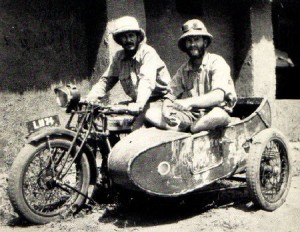 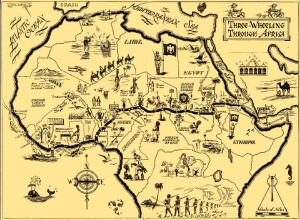 
In 1927 the two young Americans Wilson and Flood took five months to complete the first trans-African motorcycle journey we’ve heard of. They used a Triumph 5HP single cylinder, side-valve with a sidecar attached, and departed with minimal preparation. Only one of them had ever ridden a motorcycle before and in one of the reviews of the resultant book, it’s noted that they didn’t even bring servants or porters…
They shipped to Lagos in Nigeria and initially rode north towards the Sahara before heading due east to Eritrea and the Gulf. Although incredulous officials wrote ‘seen for the last time’ on their passports, and they did suffer a catalogue of mechanical failures and health issues – multiple fractures and appendicitis – they did arrive at their destination with a story to tell. Wilson for example, sacrificed his false front teeth, which were melted down to make the necessary insulation for a repair on the magneto.
The book is called ‘Three-wheeling through Africa’ by James C Wilson and was published by The Bobbs-Merrill Company. Please let us know if you ever track down a copy.
1994: Bernd Tesch visited Jim Wilson in USA/Nebrasca when he was 96 years..
http://overlandmag.com/resources/history/history-up-to-1920s/
07.10.2016 B.T. Some words,
1934
Die Mauretanien
- Route wird als Militär - Straße (Piste!) ausgebaut.
Route:
Marokko - Tindouf - Bir Moghrein - Atar - Nouakchott - Dakar.
11.12.1934
- 29.07.1935 (arrivel in Capetown.)
Theresa returned to London autumn 1935.
Florence arrived in Algiers back by motorcycle again 10th.02.1936. Return in London
ca. late march 1936.
Publication 09th.04.1936 about her return.
Theresa Wallach (British, 30.04.1909 - 30.04.1999) and Miss Blenkiron (both British)
+ 2x Transafrica London - Capetown and back See North-America as well.
1934 Theesa rode with Miss Blenkiron
London - Capetown: 14.000 miles in 8 months on a side-car with a trailer behind.
Because "Blenk" got Malaria in Johannesburg Theresa went back solo.
In German: Die beiden Brittinnen Miss Blenkiron
und Miss Theresa Wallach erreichen nach 14.000 Meilen und 8 Monaten
von London aus Capetown. Sie fuhren auf einem Gespann
Panther "Redwing" (1 - Zylinder, 600 ccm) - Gespann mit einem 2 m langen Schlafanhänger. Da Miss Wallach in Johannesburg auf der Rückreise krank wurde, fuhr Miss
Blenkiron solo bis London zurück. Route: Alger - Ain Salah - Kano
- Belgisch Congo - Uganda - Kenia - Süd - Afrika.
1997 fand ich Theresa
Wallach und hatte mir ihr brieflichen Kontakt. Sie arbeitete bis 1999 an dem 1.
Buch über ihre legendäre Transafrika-Tour. In 1999 starb sie mit 90.
1997 I found Theresa Wallach being 88.
08.10.98 A next letter to Theresa
Wallach. She just published the second edition of "Easy Motorcycle Riding"!
Since 20 years I know that the British Theresa Wallach is one of the real women
travel pioneers.1997 I found Theresa in USA and I was really happy to recieve
her first letter in July 1998 with the folowing informations: After the WW.2
Theresa rode in North-America for 2,5 years and 32.000 miles with a Norton, having
had 18 different jobs like riding horses with cowboys and trecking west with Indians
Routee 66 to pay her mc-trip. After she stopped importing British motorcycles
in USA she founded a "Motorcycle Research Riding School". In 1972 she published
a book "EASY MOTORCYCLE RIDING" of which she sold 200.000 copies. 1998 she just
finished writing two new books: "Motorcycling for Business and Leisure" (TRUE-and-TRIED"
informations) and "THE RUGGED ROAD of AFRICA". The last will be the first book
about her famous mc-tour 1934 Transafrica.
In 11.1998 I got the second edition
of "Easy Motorcycle Riding", the ABC for riders not so much for long
distance travellers. ! 17.05.1999: I got a letter from Wesley Warren Brown, that
Theresa died of liver cancer on her 90th birthday. Tears were coming to my eyes
that this woman-pioneer of motorcycling and especially motorcycle travelling died
before she finished her book about her great TRANSAFRICA-TOUR.
21.10.01 I
got the information form USA that her book "THE RUGGED ROAD of AFRICA" is published
in GB. Panther Publishing, 10 Lime Avenue, High Wycombe, Bucks HP11 1DP.
15.11.01
I tried by many, many letters to different persons to get the information, what
happened with Theresas manuscript, the fotos and old articles of her mc-travels.Finally
I got the information that all is stored in Arizona State University Foundation.
The boos - Mr. Rodney L. Houts - has been very unfriendly and not helpul from
the start until his last email. In this he forbit me to contact him again.
28.11.01 British RTW-Traveller Paul Pratt infomred me. He owns three articles
about Theresa: One piece in the motor cycle 1949 three pages photos only no text.
Two articles in the "Motor cycling" "Unconventional Traveller" - Two articles
two pages 1950. One article "The American scene" - 1951 - Two pages both have
text and photos.
Wallach, Theresa
"The Rugged Road". In English.
Transafrica in 1934. The manuscript of Theresa Wallach has been published by PANTHER PUBLISHING LTD as abook along with a video of her movie film taken during the expedition.
B.T. 22.10.01: I found British Theresa Wallach in 1998 in USA being 88 years. Then I had a wonderful exchange by letters with her. She told me that is writing first time a book about her Transafrica-tour from England with a sidecar and MIss Blenkitron to Capetwon and solo back to GB. Theresa died before the book was published. She is one of the great mc-pioneers and women-mc-pioneers.
31.05.2011 Dafne de Jong informed me about youtube: "Adventure Travel Festival". http://www.youtube.com/watch?v=2v8XK6ILoG0&feature=youtu.be

Theresa Wallach & Florence Blenkiron
Overland travel has thankfully never been the preserve of just one sex. In 1935 Theresa and Florence embarked on a ride from the UK to South Africa on a 600cc Panther motorcycle with a Watsonian sidecar and a quite amazing homemade trailer. Their route took them straight through the centre of the Sahara, then across to Kenya in the east before continuing south to Cape Town.
Both women were already experienced motorcycle racers and trials riders and Florence was a member of a very select club of riders who had lapped Brooklands at over 100mph. Their story is one of incredible achievement in a time before roads. It’s one of battles with extremes of nature and mechanical mishap and fortunately for us, Theresa wrote a book ‘The Rugged Road’ which is a terrific read to boot. It’s published in the UK by Panther Publishing and you can read a full review here.
http://overlandmag.com/resources/history/history-1930s-and-1940s/
07.10.2016 B.T.
Ca. Ostern 1934 - ca. 07.34
Robert Schultheiss
und Ernst Schröder
+ Transafrica. Cairo
- Southwest Africa. Beide fuhren 1934 mit einem Tornax - Gespann (600
ccm, engl. Jap - Motor. PS ?) von Deutschland über Cairo nach Windhoek.
26.10.95 Info von Frau M. Kreuzberger, Sam Cohen Bibliothek. Swakopmund via Frau
Arendt.
17.11.95 Ich hatte die große Freude, mit Robert Schultheiss
in Freiburg erstmalig zu telefonieren. Er berichtete mir: Er ist am 13.02.10 in
Windhoek geboren. Mit seinen Eltern war er mehrere Male in Deutschland. In Tier
lernte er seinen Freund, den Koch und Konditor Ernst Schröder, kennen, der
gerne ins Ausland wollte. Da Robert schon mehrere Male mit dem Schiff zurück
nach Windhoek gefahren war, kamen sie auf die Idee, mit dem Motorrad zurückzufahren.
Robert wußte damals von Robert Suhrs Motorrad - Reise von Windhoek nach
Deutschland, aber konnte diesen nicht vorher über diese Route befragen, da
Robert Suhr in Windhoek war.
Route: Deutschland - Schweiz -
Italien - Jugoslawien - Bulgarien - Türkei - Syrien - Libanon - Israel -
Ägypten - Sudan - Kenia - Tanganjika - Portugiesisch Ost - Südafrika
(bis Johannesburg) - Windhoek.
1934-.35
Kahler, Walter J.
KAHLER - KANE. OVERLAND - EXPEDITION
CAIRO - CAPETOWN. Autoführer..AutoreiseThe Royal - Automobil Club
of Egypte, 1934/35:
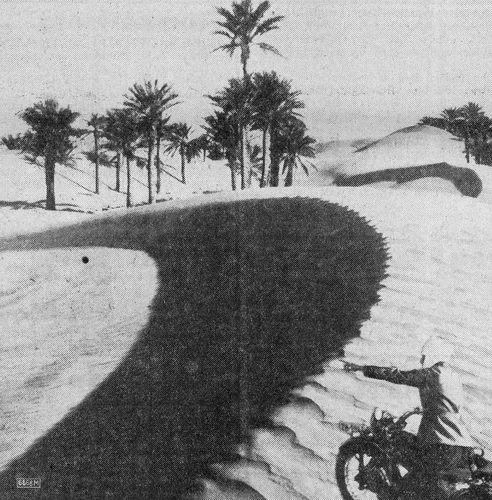 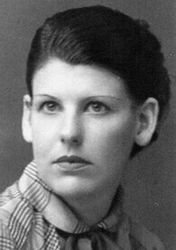
Foto oben aus MOTORRAD
1935
Valentine de Quervain (geb. 1901 in Bern, CH - 20.01.1991 in Bangalodore, India) und Werner Schwab
+
Sahara-Durchquerung 1935 auf einer Solomaschine von Osten nach Westen.
Die Geschichte steht auf 4 Seiten in einem Buch von Thomas Kohler:
Motorradfahren in der Schweiz, Band 2, 1930-1959.
10.07.2008 Erste Info von Steffen Ottinger.www.motorsport-geschichte.de
10.07.2008 Steffen um mehr Info gebeten. Will mir die 4 Seiten scannen und emailen.
28.07.2015 Steffen nochmals um die 4 Seiten als Scan gebeten.
11.03.1935 - 17.03.1935
Gustav von Selve.
Saharahahrt 1935. Erste Alleindurchquerung der Sahara mit einer BMW. Publ. Gustav von Selve. Nachfahren. 1935 ?. Es gibt nur ein Buch. Besitzer ist Michael Schulze, Germany. Motorrad-REISEBUCH-Sammler.
23.08.1935- The book
Hilde
Boehmer. Josef Böhmer. Prof. Dr. Hans Slanar. Eugen Schrott. Kurt Klemm. Ludwid Krenek (Österreicher)
Hilde
Boehmer. Buch: Mit 14 PS durch Afrika. 3 Puch. Motorrad-Expedition Kapstadt-Kairo 1935. Transafrica. Verlag: Ludwig Nath Wien III. In Deutsch. 360 S. 90 Abb. 2 Karten. 19 H x 13 B. Hardcover. 1st Austrian
edition.
1991 First info by Dr. Werner Nöther.
B.T, owns the original book.
2014 (?) Verlag Kastanienhof. Edition Motorrad. Reprint des Ludwig Nath Wien III.
1935 The film
Participants: Hilde
Boehmer. Josef Böhmer. Prof. Dr. Hans Slanar. Eugen Schrott. Kurt Klemm. Ludwid Krenek (Österreicher)
An overland expedition from Cape Town to Cairo! Six Austrians embarked in 1935 on a 14,000 km journey through Africa with three 14hp two-stroke motorcycles, each bearing a sidecar and passenger.
14 Horsepower through Africa (1935)
The vintage films at this festival are always a treat, if only to humble us modern day travellers who fancy ourselves as ‘explorers’. It’s all been done before! There exist only a few film documents from the early years of motorcycle travel. This is a rare and spectacular example from those times – an overland expedition from […]
10.02.2015: Michael Schulze::Den Böhmer-Film "Mit 14 PS durch Afrika" und die Vorgeschichte "Mit dem Motorrad ans Nordkapp" habe ich ca.2012-2013 mit meinem Freund und Namensvetter Heinz Schulze vertont. Beide Filme sind auf einer DVD enthalten, die im Verlag Kastanienhof (bei Manfred Hoffmann) veröffentlicht wurden. Du kannst die DVD direkt vom Verlag Kastanienhof oder aber z.B. über Amazon bestellen (kostet glaube ich 19,95€). Manfred hat auch die Rechte am Filmmaterial erworben. Ich habe die Filme in den letzten beiden Jahren in der Karawane in Duisburg, in Wien und bei Touratech gezeigt.
Wir haben die Filme auch in einer englischen Version vertont und uns für das Adventure Travel Film Festival von Austin Vince und Lois Pryce beworben und waren sehr happy, dass wir den Afrikafilm letztes Jahr in London zeigen konnten; die Resonanz in England war fantastisch. Die Filme die nun in Australien laufen sind die gleichen, wie beim englischen ATFF. Nur leider werde ich in Australien nicht "life" dabei sein...Die englischen Versionen sollen evtl. auch dieses Jahr auf DVD herauskommen.

The vintage films at this festival are always a treat, if only to humble us modern day travellers who fancy ourselves as ‘explorers’. It’s all been done before! There exist only a few film documents from the early years of motorcycle travel. This is a rare and spectacular example from those times – an overland expedition from Cape Town to Cairo! Six Austrians embarked in 1935 on a 14,000 km journey through Africa with three 14hp two-stroke motorcycles, each bearing a sidecar and passenger. On they plough, across a continent totally devoid of asphalt and wearing what nowadays could only be described as ‘fancy dress’. Along the way they also climbed Mount Kilimanjaro before crossing the Sahara desert. They bounce their way back to Vienna, team and bikes intact, just in time for the Anschluss and WWII. If you need inspiration that it’s all about your attitude and not your equipment, this is it.
Black and white 16mm, 50 mins.
12.02.2016
Shown on the Australian Festival. http://www.adventuretravelfilmfestival.com/
1938
Daniel-André Douard (French)
+ Erste Sahara-Durchquerung via Tanezrouft. Der Franzose Daniel-André Douard (s. Malachowski ) war 1938 der erste Motorrad-Fahrer, der die Sahara via Tanezrouft-Route solo durchquerte.
Malachowski, Dr. et Daniel-André Douard (Daniel-André geb. 20.12.1911. Dr. Malachowski starb 1942) Buch: La Traversée Du Sahara. Seul en Vélomoteur par le Garde Républicain Douard.
Deutsch : Die Durchquerung der Sahara. Alleine mit dem Moped durch den „Garde Républican Douard“. Buch über die erste Motorrad-Durchquerung alleine durch die Sahara auf der Tanezrouft-Piste von Süden nach Norden Richtung. Als Motorrad diente ein „Moped“ (100 ccm, 3 Gänge), eine französische „Prester-Jonghi“. Der Arzt und Betreuer Dr. Malachowski schrieb das Buch mit André.
Strecke : 1930 km ab Gao (Mali) - Kidal - Aguelhook - Bidon V (Algerien) - vorbei an Ouallen - Reggane - Adrar - Colomb Bechar: 17.02.38-06.03.1938. 168 S. Keine Fotos. 1 Kartenskizze. Französisch. Bibliothek. Verlag: Les editions de France. Paris. Frankreich. 10.01.1939. Bezug: 20 Ave Rapp, VII e. 1939.
Hardcover-Ausgabe: Es gibt noch eine Hardcover-Ausgabe mit dem gleichen Inhalt und vom gleichen Verlag. Jedoch steht auf dem Rücken Douard als Autor.
1939
Der französische Kapitän Couet, Lieutenant Thiriat, Lieutenant Martinau und Marechall de logis Gaucher. Ab Marokko kamen Capitaine Almeras und Marechall de logis Vely dazu. Die Männer wollten die Gespanne Gnome & Rhone AX 2 unter Beweis stellen, nur ein extra Sandluftfilter wurde ausgetauscht. Mit extra Benzintanks wurde ihre Reichweite auf 600 km erweitert. Capitaine Couet überschlug sich im südlichen Marokko und mußte ausgeflogen werden. Es waren die vierten Besucher, die jemals soweit südlich kamen.
Route: Paris - Port - Vendres - per Schiff nach Oran - Algerien - Marokko (Tiznit - Tindouf ) - 1200 km bis Mauretanien (Atar) - Foum El Hasse(?)an - von dort auf LKW - Piste noch 5.300 km bis Dakar.
1939 Motorrevue Nr. 844, 845 und 846. |
